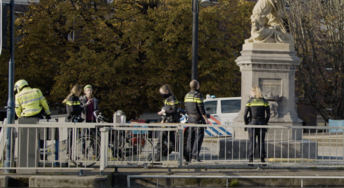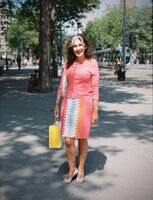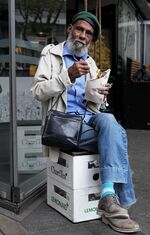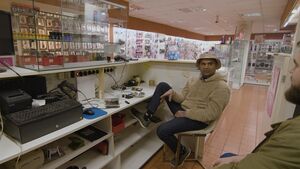Text on practice s.c.p.k: Difference between revisions
Samkoopman (talk | contribs) No edit summary |
Samkoopman (talk | contribs) No edit summary |
||
| (2 intermediate revisions by the same user not shown) | |||
| Line 1: | Line 1: | ||
<blockquote>'''"Fact is not truth. There is often no truth in fact. Otherwise the Manhattan phonebook would be the book of all books."''' <small>- Werner Herzog | <blockquote>'''"Fact is not truth. There is often no truth in fact. Otherwise the Manhattan phonebook would be the book of all books."''' <small>- Werner Herzog</small></blockquote>I do not know about the things I want to know. My practice is focused on learning, understanding and (hopefully) knowing. This pursuit exists in a collaborative sphere where I work as a filmmaker to stretch beyond this term. To listen and live with the emotions, thoughts, actions and phenomena of humans around me. Not knowing does not have to mean I am ignorant. Therefore, I make to know. | ||
[[File:Dear Moritz.png|thumb|344x344px|''Dear Moritz -'' still frame]] | [[File:Dear Moritz.png|thumb|344x344px|''Dear Moritz -'' still frame]] | ||
My current project ''Dear Moritz'', uses a hybrid form of documentary, fiction and film essay. It presents an encounter that I witnessed and captured in public space. I shot the film while waiting for a friend. We had planned to film something else, in the neighbourhood he grew up in, but he was late. While waiting near a square with one of the last colonial figure-statues in the city, I set up my camera and began filming b-roll. Suddenly, some commotion started by the foot of the sculpture between an artist and police officers. I turned my lens toward it. The artist was working on a (non destructive) intervention with the statue. There was confrontation and brief moments of tension between them. These people became the cast, and eventually so did my friend and I. Eventually, my friend of Cape Verdian descent showed up. He presented a different sort of attitude toward dealing with piece of colonial ideology than the artist and the police. We all shared a sort of common frustration and confusion. | My current project ''Dear Moritz'', uses a hybrid form of documentary, fiction and film essay. It presents an encounter that I witnessed and captured in public space. I shot the film while waiting for a friend. We had planned to film something else, in the neighbourhood he grew up in, but he was late. While waiting near a square with a statue of Piet Hein- one of the last colonial figure-statues in the city, I set up my camera and began filming b-roll. Suddenly, some commotion started by the foot of the sculpture between an artist and police officers. I turned my lens toward it. The artist was working on a (non destructive) intervention with the statue. There was confrontation and brief moments of tension between them. These people became the cast, and eventually so did my friend and I. Eventually, my friend of Cape Verdian descent showed up. He presented a different sort of attitude toward dealing with piece of colonial ideology than the artist and the police. We all shared a sort of common frustration and confusion. | ||
I did not think much of this spontaneous scene at first. I went on with my friend to film the project we had originally planned, but in the following days my mind kept tracking back to the encounter with Moritz. I watched the footage repeatedly for several weeks. Slowly I began to put together my thoughts into words, working on a script to use as a close reading voiceover to the film. The script developed through conversations with the artist, my friend and mentors. It became a way to annotate, think through and highlight certain elements. Complementing the script, I then altered the static visual-nature of the film through digital zooms and editing to stretch the fabric of the long-take shot in providing more than its pixels. The shooting and assembly of my film is a technically autonomous process but ultimately my work is a collaborative process. The artist for example, became a friend who I met with several times. Building trust and relationships is crucial to opening conversation and giving (larger than life) voice through moving images. | I did not think much of this spontaneous scene at first. I went on with my friend to film the project we had originally planned, but in the following days my mind kept tracking back to the encounter with Moritz. I watched the footage repeatedly for several weeks. Slowly I began to put together my thoughts into words, working on a script to use as a close reading voiceover to the film. The script developed through conversations with the artist, my friend and mentors. It became a way to annotate, think through and highlight certain elements. Complementing the script, I then altered the static visual-nature of the film through digital zooms and editing to stretch the fabric of the long-take shot in providing more than its pixels. The shooting and assembly of my film is a technically autonomous process but ultimately my work is a collaborative process. The artist for example, became a friend who I met with several times. Building trust and relationships is crucial to opening conversation and giving (larger than life) voice through moving images. | ||
| Line 32: | Line 32: | ||
Bazin, A. (1960) 'The Ontology of the Photographic Image' in Film Quarterly Vol. 13, No. 4 (pp. 4-9) | Bazin, A. (1960) 'The Ontology of the Photographic Image' in Film Quarterly Vol. 13, No. 4 (pp. 4-9) | ||
Blaser, M. & de la Cadena, M. (2018) A World of Many Worlds, Duke University Press | |||
Derrida, J. (1983) Dissemination, University of Chicago Press | Derrida, J. (1983) Dissemination, University of Chicago Press | ||
Herzog, W. (2020) Masterclass | Herzog, W. (2020) Masterclass [Film] | ||
Lacan, J. (1973) The Four Fundamentals of Psychoanalysis, Karnac Books | Lacan, J. (1973) The Four Fundamentals of Psychoanalysis, Karnac Books | ||
| Line 43: | Line 43: | ||
Watts, A. (1951) The Wisdom of Insecurity, Ebury Publishing | Watts, A. (1951) The Wisdom of Insecurity, Ebury Publishing | ||
'''Bibliography''' | |||
* Dear Moritz [https://vimeo.com/783363557/bf9ede1102 (Rough cut, external link)] | |||
* Cinéma vérité | |||
* Direct Cinema | |||
* Docufiction | |||
* Street Photography | |||
* Keep It in the Streets [https://www.youtube.com/watch?v=kvJyhhlqQ_U (Film, external link)] | |||
* Zen and the Art of Street Cinema [https://www.youtube.com/watch?v=QJO5vZ3Ab8g (Film, external link)] | |||
* Agnes Varda | |||
* Chick Strand | |||
* Christopher Harris | |||
* Werner Herzog | |||
* Abbas Kiarostami | |||
* Apichatpong Weerasethakul | |||
* Ana Vaz | |||
* Gus Van Sant | |||
* Béla Tarr | |||
* Gyz La Rivière | |||
* Spike Lee | |||
* Jean Rouch | |||
* Michael Haneke | |||
* The Tao of Wu by RZA (book) | |||
* The Sun Also Rises by Ernest Hemingway (book) | |||
* Artificial Hells by Claire Bishop (book) | |||
* Rick Rubin | |||
* and many more I am forgetting... | |||
Latest revision as of 07:12, 3 April 2023
"Fact is not truth. There is often no truth in fact. Otherwise the Manhattan phonebook would be the book of all books." - Werner Herzog
I do not know about the things I want to know. My practice is focused on learning, understanding and (hopefully) knowing. This pursuit exists in a collaborative sphere where I work as a filmmaker to stretch beyond this term. To listen and live with the emotions, thoughts, actions and phenomena of humans around me. Not knowing does not have to mean I am ignorant. Therefore, I make to know.
My current project Dear Moritz, uses a hybrid form of documentary, fiction and film essay. It presents an encounter that I witnessed and captured in public space. I shot the film while waiting for a friend. We had planned to film something else, in the neighbourhood he grew up in, but he was late. While waiting near a square with a statue of Piet Hein- one of the last colonial figure-statues in the city, I set up my camera and began filming b-roll. Suddenly, some commotion started by the foot of the sculpture between an artist and police officers. I turned my lens toward it. The artist was working on a (non destructive) intervention with the statue. There was confrontation and brief moments of tension between them. These people became the cast, and eventually so did my friend and I. Eventually, my friend of Cape Verdian descent showed up. He presented a different sort of attitude toward dealing with piece of colonial ideology than the artist and the police. We all shared a sort of common frustration and confusion.
I did not think much of this spontaneous scene at first. I went on with my friend to film the project we had originally planned, but in the following days my mind kept tracking back to the encounter with Moritz. I watched the footage repeatedly for several weeks. Slowly I began to put together my thoughts into words, working on a script to use as a close reading voiceover to the film. The script developed through conversations with the artist, my friend and mentors. It became a way to annotate, think through and highlight certain elements. Complementing the script, I then altered the static visual-nature of the film through digital zooms and editing to stretch the fabric of the long-take shot in providing more than its pixels. The shooting and assembly of my film is a technically autonomous process but ultimately my work is a collaborative process. The artist for example, became a friend who I met with several times. Building trust and relationships is crucial to opening conversation and giving (larger than life) voice through moving images.
My background in traditional film production and commercial filmmaking has led me to wrestling between the poles of image making within my practice. Breaking out of the friendly confines and structures of for-profit image making is a challenge that I feel urged to work through. In my 'work' experiences , I developed a deep need to think differently about what is my 'work' and 'how to work'. I developed a practice inspired by street photography, direct cinema and cinema vérité, focused on interaction with strangers.
I aim to have the people around me tell a story, their story, instead of writing one for them. This is something I still maintain as important, but my previous practice lacked a voice of authorship. It meandered in immaturity due to a passive approach lacking depth. This is also because I worked under the title of cinematographer or editor- a rich experience, but one of complement to a larger narrative or vision of another maker.
"We walk around like there's some holy moments and there are all the other moments that are not holy, right, but this moment is holy, right? And if film can let us see that, like frame it so that we see, like, "Ah, this moment. Holy." And it's like "Holy, holy, holy" moment by moment. But, like, who can live that way? Who can go, like, "Wow, holy"? Because if I were to look at you and just really let you be holy, I don't know, I would, like, stop talking." - Caveh Zahedi in A Waking Life (2001)
Dear Moritz and the work I intend to continue making straddles the border of fiction & non fiction, unclear as to what is 'real', or possibly having been preconceived by the maker. Rather than being built off of a script or interview questions, my film is formed around the notion of a ‘holy moment’ (Bazin, 1960). The physical world and its social interactions are an engine for my work. This is essential to me in providing a form where a viewer can also join me in the conversations I have en route of the pursuit of truth.
What will follow for me is a continuation of exploration into the world that I encounter and understanding it. I look to continue this approach to working with the candid and capturing public space. I am still wrestling with how to create a reliable methodology based on the unplanned, the spontaneous. A weekly exercise that continues to open possibilities in this lane and nonetheless enjoyable camera-based process is that of making portraits and talking to people in the streets.
I will also continue to build relationships with people, understand (their) stories and immerse myself in all worlds. I am intrigued with the politics of aesthetics- which exist in a battle for what is able or permissible to be seen or shown in society (Rancière, 2004). It makes me think of Marty, a man who works at the sex shop under my apartment. After he accepted a package in the mail for me when I was away, we slowly began speaking. This started slowly but led to an almost daily happening. First, a cashier-counter separated us and we spoke for just a few minutes. With time, we were going for lunch together on his break and watching films at the cinema after his shift. Now, I pop down with coffee and we hang out for hours together behind the counter. Marty is an orphan from India raised in the Netherlands and he confided in me a sort of personal, creative crisis he feels within himself. We have begun to passively battle this through our meetings, learning each other. Eventually, the camera was worked into this. Often just conversations we have are filmed, but in discussion of concepts to work towards, revolving around his experiences, spirituality and love for cooking. The project serves as a constantly developing practice of speaking with, not on people.
"To be creative is to see into the unknown and interpret it.” - Alan Watts (1951)
The current age of constant, clickable content is one I find myself contributing to as someone needing to pay bills. In an effort to counter the hyperreality of images and bring meaning to 'the real' (Baudrillard, 1981; Lacan, 1973). Akin to the studium and the punctum- I want to find a way to bring into harmony both the technical (what I've trained myself on over the last years), and the piercing, humanely connective sublime (what I'm developing now in my research) (Barthes, 1982).
Through continued research, reading, writing and making, I am understanding better the kinetic energy between them to build methodologies. Being able to see myself and my work outside the parameters of a role tied to a specific industry has been paramount for me. Since beginning at PZi, I've made an effort to watch at least one film per day. This can be any format, genre, length. The goal is to grow my omnivorous visual lexicon and understand differing approaches. Regardless of the film, I give it my attentive and analytical eye. I try to write (often short, occasionally long) any thoughts I have about the films in a diary. A process in developing a palette of plurality as a maker. It is through this that I have discovered a rich well of provocative work stretching decoloniality, feminism and more. Christopher Harris, Chick Strand and Ana Vaz provide me insight to non-linear approaches. In bridging fictional documentary, experiment and (touches of) humour, work by Denis Côté and Abbas Kiarostami and Apichatpong Weerasethakul are sources of inspiration.
I am curious about the individual and collective. At stake is the risk of losing sight of the multitude of colour in the spectrum of the world surrounding us. I refuse to let the seemingly binary nature of things remain and further polarize us. Who does what? How does power assert itself? What are the relationships between people & places? What happened today? And tomorrow? I want to understand a possibility for a world of many worlds, requiring me to challenge my own privilege and deconstructing the inscribed flurry of symbols and structures surrounding humans (de la Cadena, 2018; Derrida, 1983). At my disposal are the tools of cinema, which I can use to reach beyond and propose new narratives, perspectives and questions in audio-visual conversation.
I do not know. I may not ever know. But I will continue to learn, while never exchanging a pursuit of truth for simple fact. Human thought, spontaneity and interaction fuel me. Connection with others, conversation, friction, debate, understanding and appreciation. I feel all these things when working as an artist, and I want others to feel with me.
References
A Waking Life (2001) Richard Linklater [Film]. Fox Searchlight Pictures
Barthes, R. (1982) Camera Lucida: Reflections on Photography, Hill and Wang
Baudrillad, J. (1981) Simulacra and Simulation, Semiotext(e)
Bazin, A. (1960) 'The Ontology of the Photographic Image' in Film Quarterly Vol. 13, No. 4 (pp. 4-9)
Blaser, M. & de la Cadena, M. (2018) A World of Many Worlds, Duke University Press
Derrida, J. (1983) Dissemination, University of Chicago Press
Herzog, W. (2020) Masterclass [Film]
Lacan, J. (1973) The Four Fundamentals of Psychoanalysis, Karnac Books
Rancière, J. (2004) Politics of Aesthetics: The Distribution of the Sensible, Continuum
Watts, A. (1951) The Wisdom of Insecurity, Ebury Publishing
Bibliography
- Dear Moritz (Rough cut, external link)
- Cinéma vérité
- Direct Cinema
- Docufiction
- Street Photography
- Keep It in the Streets (Film, external link)
- Zen and the Art of Street Cinema (Film, external link)
- Agnes Varda
- Chick Strand
- Christopher Harris
- Werner Herzog
- Abbas Kiarostami
- Apichatpong Weerasethakul
- Ana Vaz
- Gus Van Sant
- Béla Tarr
- Gyz La Rivière
- Spike Lee
- Jean Rouch
- Michael Haneke
- The Tao of Wu by RZA (book)
- The Sun Also Rises by Ernest Hemingway (book)
- Artificial Hells by Claire Bishop (book)
- Rick Rubin
- and many more I am forgetting...




